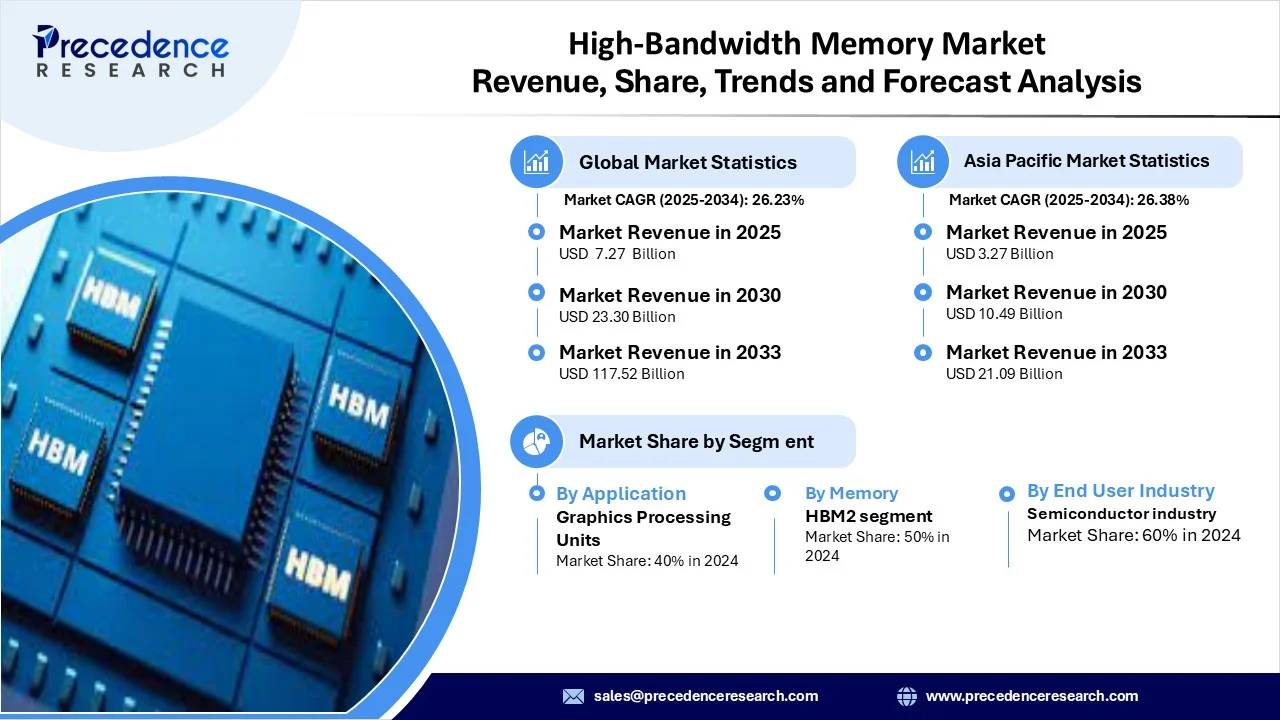High-Bandwidth Memory Market Revenue to Attain USD 46.87 Bn by 2033
High-Bandwidth Memory Market Revenue and Trends 2025 to 2033
The global high-bandwidth memory market revenue reached USD 7.27 billion in 2025 and is predicted to attain around USD 46.87 billion by 2033 with a CAGR of 26.23%. This market is growing due to the surging demand for artificial intelligence training, inference, and high-performance computing, which requires memory architectures that offer extreme bandwidth, low latency, and superior energy efficiency to handle increasingly large data workloads.

What are the key drivers of the high-bandwidth memory market?
The market is experiencing significant growth, driven by several key factors. A primary driver is the increasing demand for higher memory bandwidth and lower latency, essential for advanced applications like large language models, generative AI, and high-performance computing (HPC) workloads. This demand is pushing compute designers towards stacked DRAM architectures to meet the performance needs of modern computing. Additionally, end-users such as GPUs, AI accelerators, and custom ASICs require the extra width and increased memory bandwidth that HBM provides to avoid bottlenecks in their processing capabilities.
Another critical factor is the interplay of technology and supply chain dynamics. Advanced packaging and 3D stacking technologies are enabling HBM to scale its capacity and performance effectively. Moreover, the limited number of qualified suppliers, along with strong vertical integration between memory suppliers and AI chip customers, is creating a favorable market environment. Hyperscaler orders and aggressive capacity expansions further strain supply and pricing, making HBM an attractive investment.
Segment Insights
- By application, graphics processing units (GPUs) segment dominated the market in 2024 due to the increasing reliance on AI training, inference accelerators, and professional visualization applications that demand extreme bandwidth and low latency, making HBM the preferred memory for next-generation computational workloads.
- By memory type, the HBM2 segment led the market in 2024, because of its mature manufacturing yields, compatibility with existing ecosystems, favorable cost-per-bit compared to newer variants, and proven integration into current accelerators and platforms.
- By end-user industry, the semiconductors segment dominated the market in 2024, owing to the continued adoption of HBM by IDMs, fabless design houses, and foundries in AI accelerators, GPUs, and custom ASICs. Vertical integration and SoC co-design strategies with memory partners are further fueling demand for data center-grade performance.
Regional Insights
Asia Pacific dominated the high-bandwidth memory market in 2024 due to several key factors. Firstly, the region boasts the densest production clusters, with leading memory vendors and advanced assembly ecosystems. Secondly, countries like South Korea, Taiwan, and Japan are at the forefront of volume production and R&D in this sector. Finally, strong demand from hyperscalers and OEMs in China and India further solidified the region's leadership position, supported by a resilient local supply chain that enables shorter lead times for OEMs.
North America is expected to experience rapid growth in the market due to several factors. Hyperscalers, cloud providers, and AI startups are quickly ramping up GPU clusters, driving demand. Substantial investments in AI chips to lower latency performance, coupled with collaborations with memory suppliers on co-design, are promoting adoption. Additionally, government sponsorships and enterprise cloud migrations in both public and private sectors are significantly increasing the demand for HBM solutions.
High-Bandwidth Memory Market Coverage
| Report Attribute | Key Statistics |
| Market Revenue in 2025 | USD 7.27 Billion |
| Market Revenue by 2033 | USD 46.87 Billion |
| CAGR from 2025 to 2033 | 26.23% |
| Quantitative Units | Revenue in USD million/billion, Volume in units |
| Largest Market | Asia Pacific |
| Base Year | 2024 |
| Regions Covered | North America, Europe, Asia-Pacific, Latin America, and the Middle East & Africa |
Recent Development
- In June 2025, Micron Technology began shipping samples of its next-generation HBM4 memory, achieving a groundbreaking 2.8 TB/s bandwidth and pin speeds over 11 Gbps. This advancement positions Micron ahead of its competitors in the market.
Get this report to explore global market size, share, CAGR, and trends, featuring detailed segmental analysis and an insightful competitive landscape overview @ https://www.precedenceresearch.com/sample/6977
You can place an order or ask any questions, please feel free to contact us at sales@precedenceresearch.com |+1 804 441 9344